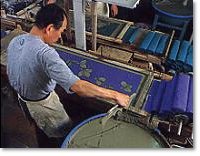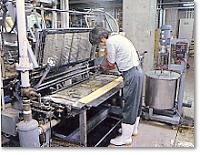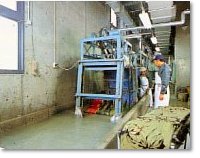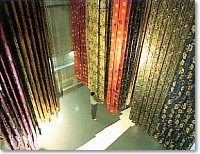| Introduction | ||

Yukata are textile products that touch the skin directly. The production
process is very delicate in a different meaning from that of precision
machines. At Futami, we are the top manufacturer in the yukata industry,
with prominent achievements and technical know-how in the design, dyeing,
and shipment of yukata. Our yukata are unrivaled. Craftsmanship and sensitivity Original machines and excellent facilities These factors should be balanced to put excellent products on the market. Our pioneering mind and enthusiasm are vividly breathing in every corner of our flexible production system that precisely grasps the current tastes and needs. |
| Processes in Dyeing |
| 1. Pattern Placing | ||

Bleached cloth is placed on a starching board. A traditional pattern called
the Ise Pattern is placed on the cloth and dye-resistant starch is spread
over the pattern with a spatula and applied to the fabric. The starched
cloth is folded in units of one pattern length, which is approximately
1 meter. One piece of cloth, equivalent to one roll, is folded 12 times
in total. Folded cloth equivalent to three or four rolls are piled up and
taken down from the starching board. To fold the cloth requires experienced
craftsmanship. Cloth with delicate patterns should be folded and handled
carefully. |
| 2. Die Pouring | ||

The starched and folded cloth is placed on a brass board and a sufficient
amount of dye is poured on top of the folded cloth. Only experienced craftsmen
with excellent dye pouring technique and sense cultivated over many years
can make delicate tones and hues unique to the dye pouring. |
| 3. Water Washing | ||

The dyed cloth is washed in water to completely remove the starch and extra dye. The craftsmen engaged in this are called Hamakata. |
| 4. Drying | ||

The water-washed cloth is spin-dried in a centrifuge, hung from the ceiling,
and dried by hot-air driers indoors. Compared with the traditional sun
drying, the process is not affected by the weather, especially in the rainy
season. |
| Last Update October 14, 2001 |